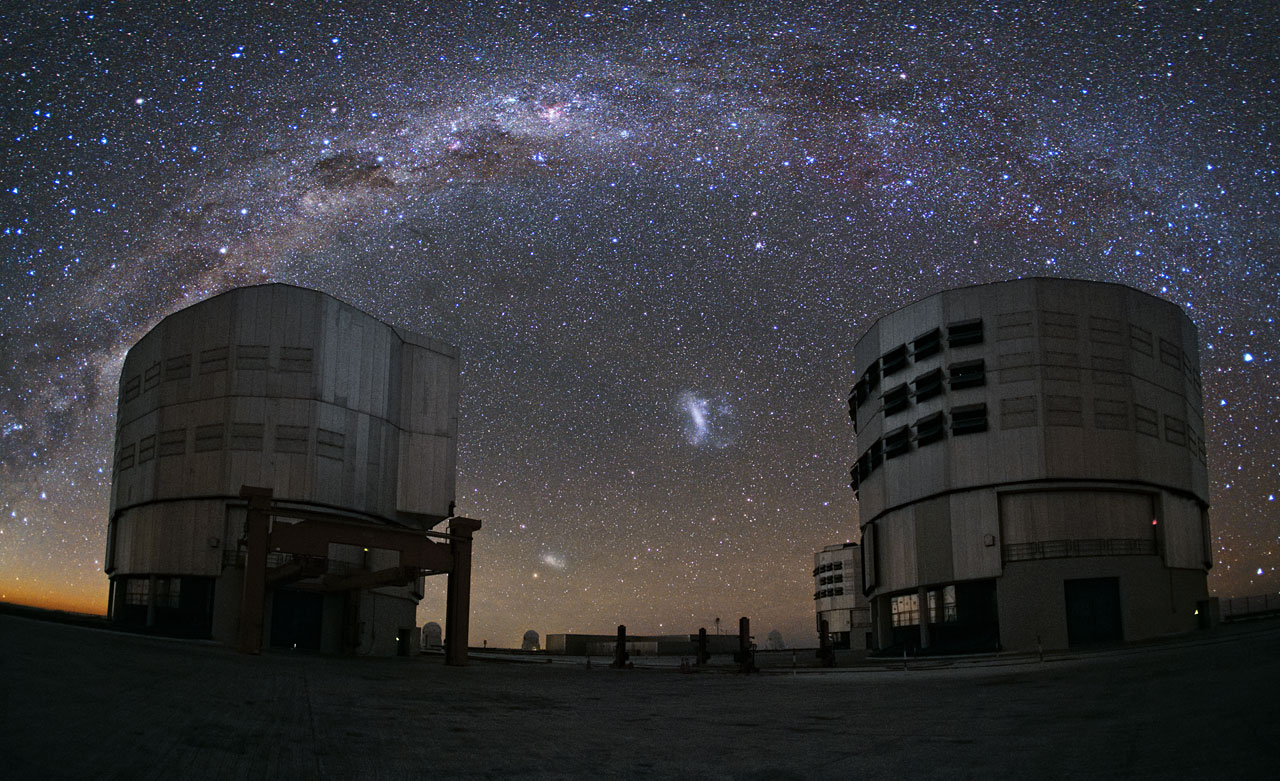Sitting atop Cerro Paranal high above the Atacama Desert in Chile, two of the Very Large Telescope's Unit Telescopes quietly bask in the starlight, observing the Milky Way as it arches over ESO's Paranal Observatory.
Several interesting objects can be seen in this picture. Some of the most prominent are the two Magellanic Clouds — one Small (SMC), one Large (LMC) — which appear brightly in between the two telescopes. By contrast, the dark Coalsack Nebula can be seen as an obscuring smudge across the Milky Way, resembling a giant cosmic thumbprint above the telescope on the left. ...
Found images: 2014 September
Re: Found images: 2014 September
Know the quiet place within your heart and touch the rainbow of possibility; be
alive to the gentle breeze of communication, and please stop being such a jerk. — Garrison Keillor
alive to the gentle breeze of communication, and please stop being such a jerk. — Garrison Keillor
Re: Found images: 2014 September
In this new Hubble image, the strikingly luminous star AG Carinae — otherwise known as HD 94910 — takes centre stage. Found within the constellation of Carina in the southern sky, AG Carinae lies 20 000 light-years away, nestled in the Milky Way.
AG Carinae is classified as a Luminous Blue Variable. These rare objects are massive evolved stars that will one day become Wolf-Rayet Stars — a class of stars that are tens of thousands to several million times as luminous as the Sun. They have evolved from main sequence stars that were twenty times the mass of the Sun.
Stars like AG Carinae lose their mass at a phenomenal rate. This loss of mass is due to powerful stellar winds with speeds of up to 7 million km/hour. These powerful winds are also responsible for the shroud of material visible in this image. The winds exert enormous pressure on the clouds of interstellar material expelled by the star and force them into this shape.
Despite HD 94910’s intense luminosity, it is not visible with the naked eye as much of its output is in the ultraviolet.
This image was taken with the Wide Field and Planetary Camera 2 (WFPC2), that was installed on Hubble during the Shuttle mission STS-61 and was Hubble’s workhorse for many years. It is worth noting that the bright glare at the centre of the image is not the star itself. The star is tiny at this scale and hidden within the saturated region. The white cross is also not an astronomical phenomenon but rather an effect of the telescope.
Know the quiet place within your heart and touch the rainbow of possibility; be
alive to the gentle breeze of communication, and please stop being such a jerk. — Garrison Keillor
alive to the gentle breeze of communication, and please stop being such a jerk. — Garrison Keillor
-
starsurfer
- Stellar Cartographer
- Posts: 5325
- Joined: Thu Mar 15, 2012 7:25 pm
Re: Found images: 2014 September
AG Carinae is an amazing star and one of my favourite massive ones! Interestingly, in the sky it makes an apparent pair with the Wolf Rayet star and nebula Hen 3-519, both could fit in a half degree field of view for any astrophotographers out there.bystander wrote:
In this new Hubble image, the strikingly luminous star AG Carinae — otherwise known as HD 94910 — takes centre stage. Found within the constellation of Carina in the southern sky, AG Carinae lies 20 000 light-years away, nestled in the Milky Way.
AG Carinae is classified as a Luminous Blue Variable. These rare objects are massive evolved stars that will one day become Wolf-Rayet Stars — a class of stars that are tens of thousands to several million times as luminous as the Sun. They have evolved from main sequence stars that were twenty times the mass of the Sun.
Stars like AG Carinae lose their mass at a phenomenal rate. This loss of mass is due to powerful stellar winds with speeds of up to 7 million km/hour. These powerful winds are also responsible for the shroud of material visible in this image. The winds exert enormous pressure on the clouds of interstellar material expelled by the star and force them into this shape.
Despite HD 94910’s intense luminosity, it is not visible with the naked eye as much of its output is in the ultraviolet.
This image was taken with the Wide Field and Planetary Camera 2 (WFPC2), that was installed on Hubble during the Shuttle mission STS-61 and was Hubble’s workhorse for many years. It is worth noting that the bright glare at the centre of the image is not the star itself. The star is tiny at this scale and hidden within the saturated region. The white cross is also not an astronomical phenomenon but rather an effect of the telescope.
-
starsurfer
- Stellar Cartographer
- Posts: 5325
- Joined: Thu Mar 15, 2012 7:25 pm

